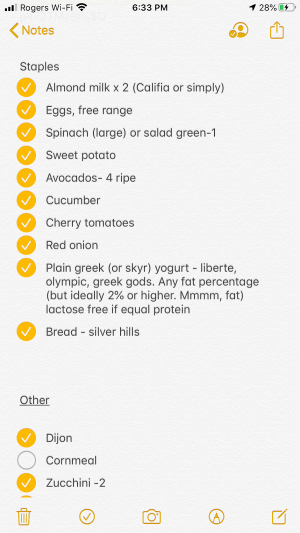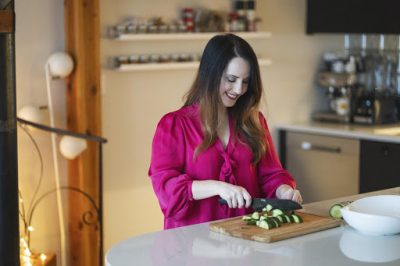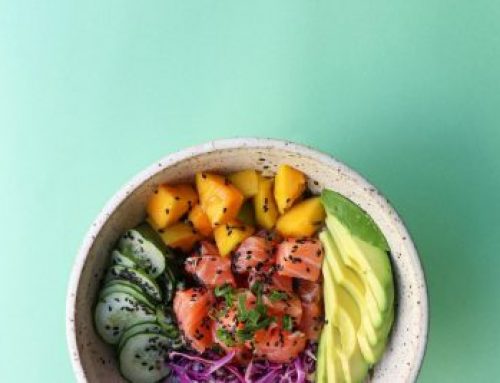Having a healthy meal plan habit makes eating well happen during the week. Did anyone else think it was going to be easier to eat well if you weren’t going out all the time, or had time to cook during the day? Me too. But the reality is it has been a tough month food wise for many and we’re feeling more scattered, not less.
What is the gap between trying to eat healthy, and actually doing it?
It’s not willpower, or genetics, or self control, or shopping at a fancy organic grocery store (although those are all great things). The #1 thing my most successful clients do is meal plan.
If you find yourself asking the dreaded “what’s for dinner” every day, you need to shift your focus from “what” you should be eating to making some sort of meal planning happen each week. You’ll eat healthier by not leaving it up to chance or mystical 5pm weeknight meal inspiration. You’ll feel less stressed throughout the week, and save a whole lot of energy usually spent figuring out what to eat. How awesome would it be to never ask the dreaded question again?
What healthy meal planning isn’t:
That does not have to mean 28 days of freezer meals and 7 hours slaving over the stove every Sunday (count me out). How you plan and prep should work for your style of cooking, time available, and preferences! There’s no one “right way” to do it.
What you do need to do consistently:
1. Find a style of healthy meal planning that works for you!
From loose structure, to prepped and ready to go by Monday for the whole week. Whatever works, works.
Some questions to ask:
- What days do I have some quiet time to plan or prep?
- Is anyone helping me plan or going to want input?
- How much time do I have to cook dinner or make lunches during the week? Do I LIKE cooking during the week, or usually fall off track because I’m tired.
- What feels better – coming home to a meal that just needs heating, or some time in the kitchen each night?
- Are there any “fright” nights where everyone has something going and there is never enough time?
- Use those answers to guide whether you are going to cook often, or in large batches less frequently, and what days you might be able to make a date to do your planning.
2. Make a date and prioritize it like it’s KEY for healthy eating (because it is)
The key to long term results? Keep it consistent. Healthy meal planning is a skill, and also a habit. Habits don’t get that way until you’ve done them over and over, and your brain has noticed that life is easier when you do them.
My most successful clients plan at roughly the same day/time each week – it’s a priority, and they’re clear that the rest of their good choices and health stem from getting those foods on the table instead of leaving it to chance. Put this date on your calendar! Nerdy, but it works. Set a reminder if you need one (I do!).
3. Streamline your planning to keep it doable
Streamline your meal planning, so it gets easier every week and takes effort off your plate. Sustainability comes from having do-able goals and strategies, not all-in sprints of effort.Some of the ways I do this:
Keep a much loved list – make a list of healthy-ish meals that you and your family enjoy and keep it somewhere handy to pull out each time you plan your week. It might be a document on your laptop, a note on your fridge, or if you’re like us a shared note in your phone.
Save previous meal plans and grocery lists to reuse on busy weeks. No need to reinvent the wheel every 7 days!
Stick to adapting meals you love (like throwing a great bagged salad or coleslaw on the side of burgers instead of fries, or making your pasta half zucchini noodles and half regular) for 80% of your plan, and keep to 1-2 new recipes a week to prevent overwhelm. A healthy meal plan should be a doable one, week after week.
4. Make a thorough grocery list instead of winging it at the store
Don’t skip this step! Having a thorough grocery list means you’re much less likely to find out you’re missing a key ingredient of your healthy meal plan at dinner time and end up defaulting to pizza. It also ensures you have enough key foods – healthy proteins and low carb veggies – to last you all the way through the week so you’re making less trips to the store.
I like to keep a running or “evergreen” grocery list so that our staples are always on there (I’m not re-inventing the wheel) and we never run out of key spices, greens or other foods that we use often. As soon as we finish 3/4 of the bottle, food or item, it goes on the list so whoever does the shopping is up to date. Groceries from our meal plan? Right on the list.
My favourite way to do this? A shared note on our phones. It updates each other automatically, and we can use the “checklist” feature to let the other know it’s been picked up. Simple, low tech, and shareable!

How to adapt to the weird grocery shopping environment right now:
I get it. With social and physical distancing, we’re shopping less and with the panic buying and supply chain challenges some of our favourite staples aren’t in stock. It can feel hard to plan, but don’t give up the habit completely.
- Be flexible in your meal choice – instead of a super complex meal, try to stay simpler like stir fries, lettuce wraps, or grilled protein and veggies that you can have an idea for, but also swap in other proteins/veggies depending on what’s available.
- Have some frozen veggies on hand to roast or throw into store bought soups/chilis to boost nutrients when your veggie crisper is low.
- Try swapping in starchy veggies like sweet potato, butternut squash (I like the cubed stuff, much less work) or corn as a starchy side if you’ve been relying too heavily on the pantry carbs like pasta, white rice, or bread. Starchy veggies keep for a while as long as it’s dark and cool, so no pressure to eat them right away.
- Some of my favourite flexible protein meals:
- Burgers: you can do turkey, lamb, chicken, or pork if beef isn’t available.
- Stir Fries and curries: you can sub just about any protein above, frozen shrimp, or even canned chickpeas if your usual chicken isn’t around
- BBQ dinners! I love grilled veggies, try peppers, zucchini, asparagus, mushrooms, onions, eggplant, or other hearty veggies. Pair with whatever protein is in your freezer!
- Healthy all in one bowls – use whatever grains (rice, quinoa), proteins (fish, chicken, frozen edamame) and chopped up veggies you have! Throw together a peanut sauce or drizzle a pre-made dressing and you’re good to go.
Finding new places and ways to shop:
Lots of stores have really long delivery waits right now. I love Instacart and we’ve been using it weekly. I can order groceries early in the week to save time, and add/update things right up until the shopper is in the store! It’s really helped keep us on track without feeling like we need to have more than a week planned at a time.
Local producers are offering curbside pickup and delivery. Heritage Meats, Meridian Meats and Central Park Farms are great options for protein foods.
Some of the smaller produce stores are really well stocked – they tend to be tighter quarters so you may want to wear a mask. We’ve had good luck with produce at Ralph’s Farm Market and Cloverdale Country Farm Market.
The next step to try is meal prep, you can find out how you can adapt it to fit your schedule, and some simple ways to save time for the week (without giving up your whole weekend) here.
Need some help getting your meals for the week balanced and prepared? If you’d like to receive our free Meal Planning Getting Started Guide AND get in on our weekly emails about all things nutrition so you can get clarity and confidence on what you’re eating, join us here!





